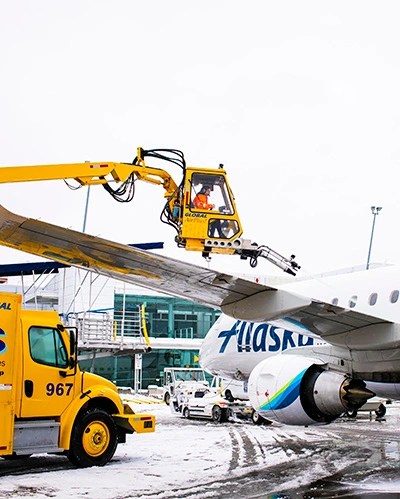
Alaska Airlines made this announcement:
Everyone knows snow can make the holidays extra cozy. But it can also cause headaches for people traveling during the ‘most wonderful time of the year.’
Pacific Northwest forecasts are calling for the possibility of snow beginning this weekend and continuing throughout the week. We could see up to three separate snowstorms that could span rain/snow showers to snow actually accumulating on the ground.
At Alaska, we’re prepared to pull every lever to get you to your holiday destination, but disruptions from the snow and ice do happen. While our team is working hard to get guests where they need to go, we want to share some of the reasons why we do what we do:


Why do the impacts feel worse in Seattle?
Seattle is Alaska’s hometown, and our operations represent the largest percentage (by a wide margin) of departures and arrivals at Seattle-Tacoma International Airport (SEA) compared to other airlines. Because of this, more of our guests are impacted when something impacts operations at Seattle. If another airline’s main hub got hit with a snowstorm, hurricane or power outage, they would be disproportionately impacted.
For context, SEA has a very small footprint by acreage compared to other metropolitan airports. This constrains our ability to deice our entire schedule of flights in wintry weather. Because the space doesn’t allow for that type of volume, we have to thin out our schedule to keep planes moving.

Why do we cancel flights before snow arrives?
We use numerous tools and resources to help us predict the weather. When our forecasts tell us to expect snow or ice, we know we need to act. Freezing temperatures and precipitation mean that we need to deice our aircraft before they can safely fly (more info on that below). Much like putting chains or studded tires on your car before hitting a snowy road, deicing aircraft slows down our operation. This means we can’t move our normal number of aircraft into and out of the airport. In order to reduce traffic jams, we need to proactively cancel flights from our schedule so we can keep as many aircraft moving as possible.
If we need to cancel flights, we try and let impacted guests know as early as possible. This means it could look clear and beautiful outside, but your flight tomorrow may have been canceled.


Why does an airplane need to be deiced?
Whenever there’s any snowfall or ice on our aircraft, we begin deicing procedures as part of our safety protocol. Aircraft cannot safely operate if there is snow or ice accumulation on the wings or tails, so it’s critical that we remove it before takeoff.
We have a full fleet of trucks, equipment and personnel across our stations ready to do that work, along with a well-stocked amount of deicing solution. They work as quickly as the airport and weather conditions will safely allow.
- Download our mobile app to check-in, pay for bags and stay up to date on any changes to your reservation—it’s like having a travel agent at your fingertips. Learn more.
- Always check the status of your flight before heading to the airport. You can do this on our mobile app or alaskaair.com.
- Allow extra time to travel to the airport and navigate security.
- Stay up to date on restrictions for unaccompanied minors and pets flying in the cargo hold. Often during winter weather, we will impose these restrictions to keep everyone safe. Learn more.
- Bookmark Alaska’s News & Stories page for the latest updates.
If your flight has been canceled, you will be contacted and reaccommodated on another flight. You will be emailed a special phone number to call if you need further help with your reaccommodation.
Top Copyright Photo: Alaska Airlines Boeing 737-790 WL N622AS (msn 30165) SEA (Brian Worthington). Image: 959669.
Alaska Airlines aircraft photo gallery (Boeing):

- SEO Powered Content & PR Distribution. Get Amplified Today.
- Platoblockchain. Web3 Metaverse Intelligence. Knowledge Amplified. Access Here.
- Source: https://worldairlinenews.com/2022/12/17/alaska-airlines-is-preparing-for-more-snowstorms-at-its-sea-hub-for-the-holidays/




